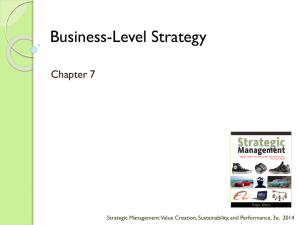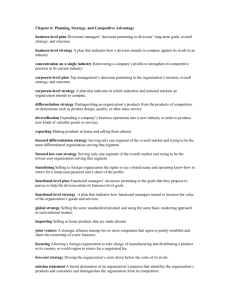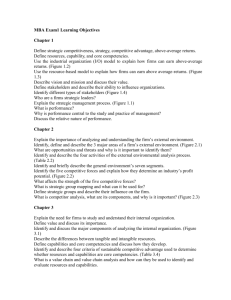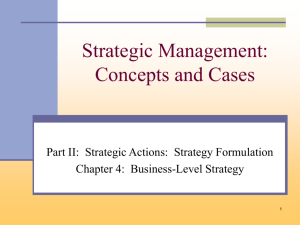Chapter 4
advertisement
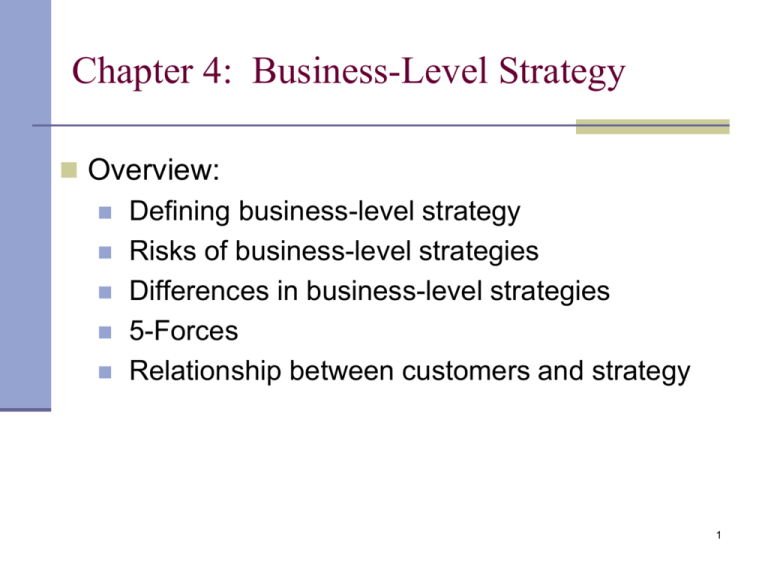
Chapter 4: Business-Level Strategy Overview: Defining business-level strategy Risks of business-level strategies Differences in business-level strategies 5-Forces Relationship between customers and strategy 1 Introduction Strategy: Increasingly important to a firm’s success and concerned with making choices among two or more alternatives. Choices dictated by External environment (O and T) Internal resources, capabilities and core competencies (S and W) Business level-strategy: Integrated and coordinated set of commitments and actions the firm uses to gain a competitive advantage by exploiting core competencies in specific product markets/industry How we intend to compete in a specific industry or product market 2 Business-Level Strategies Purpose: To create differences between position of a firm and its competitors Positioning and strategic group mapping Firm must make a deliberate choice to Perform activities differently Perform different activities This choice impacts how value chain activities are performed to create unique value No single strategy is better than others Contingent on internal and external environment 3 Business-Level Strategies Two types of competitive advantage firms must choose between Low Cost (Are our costs LOWER than rivals costs?) Distinctiveness (Are we DIFFERENT than rivals?) Two types of ‘competitive scope’ firms must choose between Broad target Narrow target The combination of competitive advantage and competitive scope yield 5 major strategic options at the business level Each strategy can potentially be used by any organization 4 competing in any industry Five Business-Level Strategies 5 Types of Business-Level Strategies Cost Leadership Strategy Competitive advantage: THE low-cost leader and operates with margins greater than competitors Competitive scope: Broad Integrated set of actions designed to produce or deliver goods or services with features that are acceptable to customers at the lowest cost, relative to competitors No-frills, standardized or commodity-like product Must have competitive levels of quality, service, and other features and lowest overall costs Continuously reduce the costs of and increase the efficiency of value chain activities 6 Examples of Value-Creating Activities Associated with the Cost Leadership Strategy 7 Types of Business-Level Strategies Cost Leadership Strategy In relationship to the 5 competitive forces: Existing Rivalry Rivals hesitate to compete on the basis of price Bargaining Power of Buyers (Customers) Powerful buyers are limited in their ability to force the cost leader to reduce prices Bargaining Power of Suppliers Cost leaders can absorb supplier price increases Potential Entrants Efficiency can serve as a barrier to entry Product Substitutes Can reduce prices when faced with substitutes Thus built in defense against all 5 competitive forces Also ability to compete based on costs and prices 8 Types of Business-Level Strategies Cost Leadership Strategy Competitive Risks Innovations by competitors can quickly eliminate cost advantage Too much focus on cost reduction versus competitive levels of differentiation Competitors may learn how to successfully imitate a cost leader’s strategy 9 Types of Business-Level Strategies Differentiation Competitive advantage: Differentiation/uniqueness Competitive scope: Broad Integrated set of actions designed by a firm to produce or deliver goods or services at an acceptable cost that customers perceive as being different/unique in ways that are important to them Targeted customers perceive product value Customized products – differentiating on as many features as possible Can differentiate in many ways and in many value chain areas 10 Examples of Value-Creating Activities Associated with the Differentiation Strategy 11 Types of Business-Level Strategies Differentiation In relationship to the 5 Forces: Existing Rivalry Customers loyalty to differentiated products reduces their sensitivity to price increases Bargaining Power of Buyers (Customers) Uniqueness and loyalty reduces customer’s sensitivity to price increases Bargaining Power of Suppliers Because of higher margins supplier price increases can be passed on the to the customer Potential Entrants Customer loyalty and uniqueness can serve as substantial barriers to new entry Product Substitutes Customer loyalty effectively positions firm against substitute products Again built in defense against 5 competitive forces 12 Types of Business-Level Strategies Differentiation Risks Can charge too high of a price premium Differentiation theme no longer valuable to customers Over-differentiating Customer experience shows differentiation not worth the cost Counterfeiting 13 Types of Business-Level Strategies Focus strategies Competitive advantage: Cost Leadership or Differentiation Competitive scope: Narrow An integrated set of actions taken to produce goods or services that serve the needs of a particular competitive segment Attractive when: Firm lacks resources to compete in the broader market Firm may be able to more effectively serve a narrow market segment than larger industry-wide competitors Firm has resources well suited to the niche Niche is attractive Large firms may overlook small niches 14 Types of Business-Level Strategies Focus strategy examples Particular buyer groups Different segment of a product line Youths vs. senior citizens Men vs. women Professional vs. do-it-yourself painters Luxury vs. sport cars Geographic markets West coast vs. East coast North America vs. Europe 15 Types of Business-Level Strategies Focused Cost Leadership Competitive advantage: Low-cost Competitive scope: Narrow industry segment Motel 6, Kia Focused Differentiation Competitive advantage: Differentiation Competitive scope: Narrow industry segment Ritz-Carlton, Apple, Rolls Royce 16 Types of Business-Level Strategies Focus strategies Risks Same basic risks as broad cost leadership or broad differentiation plus: A competitor may be able to focus on a more narrowly defined competitive segment and "outfocus” the focuser A company competing on an industry-wide basis may decide that the market segment served by the focus strategy firm is attractive and worthy of competitive pursuit Customer needs within a narrow competitive segment may become more similar to those of industry-wide customers as a whole 17 Types of Business-Level Strategies Integrated Cost Leadership/Differentiation Efficiently produce products with differentiated attributes Efficiency: Sources of low cost Differentiation: Source of unique value Involves engaging in primary and support activities that allow a firm to simultaneously pursue low cost and differentiation Low price with somewhat highly differentiated features More value for the money Often called best-cost or a hybrid strategy Examples: Toyota, Target 18 Types of Business-Level Strategies Integrated Cost Leadership/Differentiation Risks of Integrated Strategies Harder to implement than other strategies Must simultaneously reduce costs while increasing differentiation Can get ‘stuck in the middle’ resulting in no advantages and poor performance 19 Types of Business-Level Strategies The Relative Nature of Business-Level Strategies Competitive advantages are always relative to other firms As are the competencies and capabilities they are based on To be successful Low cost firms must have the lowest overall costs Differentiated firms must have higher levels of differentiation Having the same level of costs and/or differentiated features as a competitor is unlikely to lead to a competitive advantage over them 20 Other Business-Level Strategies Strategic Alliances and Partnerships (Chapter 9) Mergers and Acquisitions (Chapter 7) Vertical Integration (Chapter 6) Outsourcing (Chapter 3) Offensive and Defensive Strategies (Chapter 5) First-Mover Advantages and Disadvantages (Chapter 5) Business Model Functional Area Strategies 21 Customers and their Relationship with Business-Level Strategies Strategic competitiveness results when firm can satisfy customers by using its competitive advantages Five components in customer relationships Effectively managing relationships w/ customers Deliver superior value and build customer loyalty Reach, richness and affiliation Access and connection to customers, depth and detail of information, and facilitating interactions with customers Who: Determining the customers to serve What: Determining which customer needs to satisfy How: Determining core competencies necessary to satisfy customer needs 22
